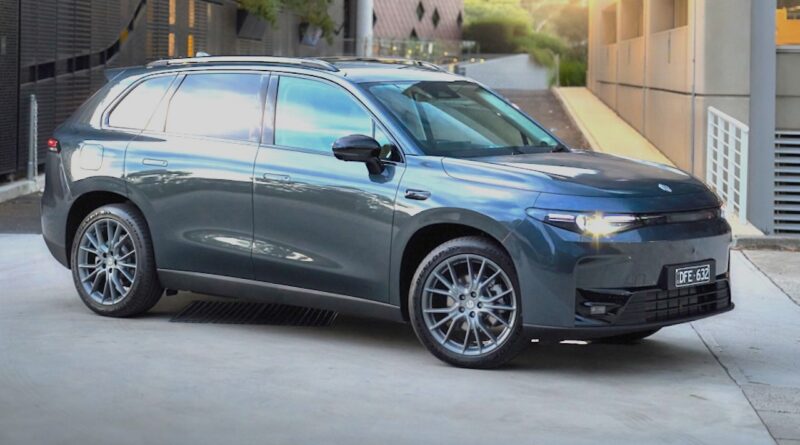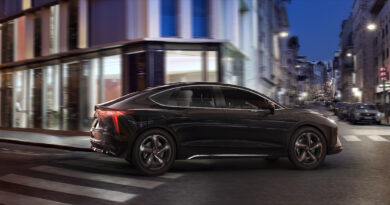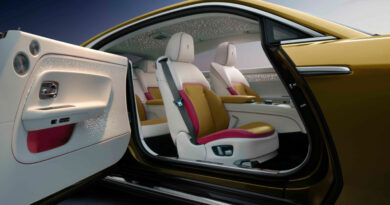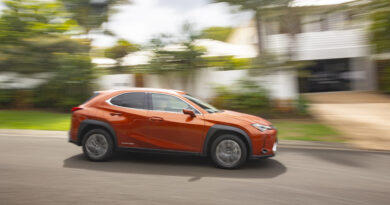2025 Leapmotor C10 REEV Design Review: Is this range-extender SUV the most frustrating new car on-sale in Australia today?
Leapmotor, if you didn’t already know, is one of the phalanx of new Chinese brands arriving in Australia.
With the backing of global auto giant Stellantis (Jeep, Alfa Romeo, Fiat, etcetera) it launched the battery electric C10 medium SUV (of course) here in February and has now followed that up with the petrol-electric range-extender model.
READ MORE: Australia’s only range extender! 1150km-claim Leapmotor C10 Ultra Hybrid arrives to challenge BYD Sealion 6 and Jaecoo J7 PHEVs
READ MORE: Leapmotor gets serious! Huge upgrades for 2026 Leapmotor C10 electric SUV make it a serious rival for Tesla Model Y and BYD Sealion 7
READ MORE: Seven day test: 2025 Leapmotor C10 Design EV. I’ll check back when you’ve finished it
Where the C10 BEV runs solely on electricity, the REEV (range extender electricity vehicle) adds a petrol engine to help recharge the battery. Like the BEV the battery can use brake regeneration to recharge and also be plugged.

But unlike a plug-in hybrid electric vehicle such as the BYD Sealion 6, the engine in the C10 REEV (also called an EREV – extended range electric vehicle – by some brands) does not drive the wheels directly.
The result in terms of range is pretty impressive. Under the loose NEDC protocol, the EV range is 170km and combined range tops out at 1150km (that’s when the 50-litre tank of unleaded driving the naturally-aspirated 1.5-litre engine is drained). The C10 EV claims a 480km NEDC range.
2025 Leapmotor C10 REEV Design price and equipment
As per the Leapmotor C10 BEV, the REEV comes in Style and Design specifications.
The C10 REEV Style is priced from $45,900 drive-away and the Design we’re testing here from $49,900 drive-away. These prices were promoted as expiring on June 30, but they’re still being offered on the Leapmotor public website.
The dollar saving compared to the BEV Style and Design varies depending what state you live in, but it is thousands of dollars.
Compared to other plug-in petrol-electric SUVs it easily undercuts the Mitsubishi Outlander PHEV and also undercuts – by a lesser amount – the aforementioned Sealion 6. There’s an ever-expanding number of PHEV medium SUVs headed our way including a new-gen Toyota RAV4 in 2026, so do your research.

Mechanically the C10 REEVs are identical, so it all comes down to the equipment. Design exclusives include 20-inch alloy wheels (up from 18s), a power tailgate, rear privacy glass, heated and ventilated front seats, a heated steering wheel, synthetic leather seat trim, multi-colour ambient lighting and an air quality monitor added to the heat pump dual-zone climate control.
Key shared equipment – and we’ve plucked these from a much longer list – includes LED auto headlights, a panoramic fixed glass roof with shade, powered front seats and the ability via vehicle-to-load (V2L) to access the battery for charging electrical items (if you purchase an aftermarket cable to access it; Leapmotor doesn’t provide one).
There’s a 14.6-inch infotainment touchscreen on the dash using super-fast Qualcomm chipsets and a 10.25-inch digital instrument panel in front of the driver. There are USB ports and wireless phone charging, embedded sat-nav, digital and FM radio and apps including Spotify. A 12-speaker audio system pumps out the sounds.
The safety assist package is impressive in its depth if not its execution – more on that later – and includes autonomous emergency braking, adaptive cruise control, various lane keeping assist, rear cross traffic monitoring and braking, blind spot detection and driver monitoring.
There are seven airbags and a very clear 360 degree camera. ANCAP has awarded the C10 BEV five stars, but that rating has yet to be extended to the REEV.

For now at least there’s no Apple CarPlay/Android Auto smartphone connection – that’s coming soon apparently. AM radio, front parking sensors or any form of spare tyre is not part of the package. The only standard paint colour is white. You’ll pay $990 for any other choice.
The Leapmotor C10 REEV comes with a six year/150,000km vehicle warranty, an eight-year/160,000km high voltage battery warranty, eight years capped price servicing with short 10,000km/12 month intervals and eight years roadside assist.
2025 Leapmotor C10 REEV Design: What we think
Not that long ago my colleague Iain Curry conducted one of his popular Seven-Day tests of the Leapmotor C10 BEV. What he found then was a fundamentally sound mechanical package overlaid with some really annoying command and control flaws.
Well, the C10 REEV proves again that Leapmotor has got the technical skills to present a solid mechanical package. But so much of what’s overlaid is just so annoying.
It should simply not be such a chore to drive. The amount of pre-drive checks and adjustments you go through would make a Qantas captain proud.
Let’s see; settings-ADAS-lane departure warning-off-yes-emergency lane keeping-off-yes-swipe down-driver monitoring-disable-yes-intelligent speed warning-disable.

You have to do all this because the monitors are just so intrusive – either bing-bonging for some alleged misdemeanour or other or corrupting the steering with unwanted and unexpected inputs – that you have no choice but to cancel them. Every. Time. You. Get. In. The. Car.
Leapmotor says it’s already had one go at retuning this stuff to make it less overweening. Back to the drawing board Leapers.
Once on the road there’s too much drilling into the touchscreen required, with steering wheel rollers and stalks the only physical controls. Leapmotor really needs to rethink this and bring back to the centre stack the most basic commonly used buttons and dials for audio and air-con at least.
Then there’s the key card that opens and locks the vehicle by tapping the sensor on the driver’s mirror. The alternate is access via a smartphone app. Neither really appeals to me.
It’s a pity all this, because the actual drive experience is good. Engineers from Maserati (a Stellantis brand) have produced a dynamic tune that is compliant, comfortable and reliable allied with light and easy steering (that can be tuned through multiple modes if you want to fiddle with the touchscreen even more). This is a family car designed to soak up the bumps and motor along efficiently and quietly.
In those terms it’s resolution is among the upper echelons of Chinese vehicles.
The amount of space in the 4739mm-long C10 also supports its family duties. It’s got heaps of tall-people-friendly room in the back seat and a number of creature comforts as well – dual map pockets, fold down armrests, door pockets, dual USBs and adjustable air-con vents.

The boot starts at 546 litres and expands to 1375 litres with the back seats folded. There’s storage under the floor including charge cables, but no frunk – that’s where the engine sits. There are a claimed 26 storage compartments spread around the cabin. I didn’t double-check, but there are certainly enough to account for the modern day crap we all drag along.
Everything also appears well put together in here. Things like seat comfort and size are positives. You sit high with a great view out.
And the powertrain? Well, it really does have substantial range. The 28.4kWh lithium ferrous phosphate battery was capable during our testing of a comfortable 80-100km before the petrol engine kicked in to sustain the charge at around 20 per cent.
With multiple modes for different aspects of the drive experience that range is undoubtedly tuneable.
With the same electric motor as the EV driving the rear wheels via a single speed reduction gear, the REEV is acceptably responsive. But at nearly 2.0-tonne before loads are added it’s never going to be lithe. The petrol engine, when it does kick in, is detectable but stays in the background.
There is an upgrade kicking around that would improve performance, but it still not confirmed for Australia.
In the end, our real world economy numbers came in at 18.5kWh/100km and 8.5L/100km versus the 15.2kWh/100km and silly 0.9L/100km consumption claims.
The best range estimate was about 1000km combined.

Recharging rates aren’t quick at a max 65kW DC. But as long as we recharged each night on a 240V wall socket the C10 REEV was more than capable of doing all our runabouts without needing the petrol engine.
But I would love a light in the charge port to see what I am doing at night. The need to lock/unlock the charge port lid via the touchscreen (!) wasn’t optimal either.
2025 Leapmotor C10 REEV Design: Verdict
This is such a frustrating vehicle. The fundamentals are solid, but the layers of audio and visual poop over the top and the lack of physical controls detract enormously from the experience.
As much as I respected the way it drove from a powertrain and chassis perspective and as much as I appreciated the amount of interior space, the other stuff would simply drive me bonkers to live with.
Fix the issues and this becomes a really impressive vehicle.
SCORE: 3.0/5
2025 Leapmotor C10 REEV Design specifications
Price: $49,900(driveaway)
Basics: REEV, 5 seats, 5 doors, medium SUV, FWD
Range: 170km EV (NEDC)/1150km combined (NEDC)
Battery capacity: 28.4kWh
Battery warranty: Eight years/160,000km
Energy consumption: 15.2kWh/100km (NEDC)
Fuel consumption: 0.9L/100km (NEDC)
Powertrain: 1.5-litre four-cylinder petrol
Motors: 1 rear, 158kW/320Nm.
AC charging: 6.6kW
DC charging: 65kW
0-100km/h: 8.5 secs





The C10 drives really well and is comfortable. ADAS should be fixed in the next update August 2025. The discounted dealer pricing and 1.9 percent financing was very hard to pass up.
In terms of charging port unlocking; we don’t have that issue. After charging from a Tesla mobile charger (Type 2) the port automatically unlocks and I just have to pull it out.
I’ve had my REEV for almost 8 weeks now and clocked up over 7500klms and overall have to agree with all your comments and as such I’m in regular contact with Leapmotor re issues beyond tge ADAS ones mentioned and to their credit they’ve been responding positively. In addition to the charge port lighting I’ve suggested the door handles and the tailgate button also need lights. Your fuel/electricity usage is higher than mine, I’m getting between 14-17kwh and fuel wise the worst.ive seen in power mode was 6.2 litres per 100klm. Re acceleration initial take off is slow but rolling acceleration is excellent especially for powering out of corners, roundabouts etc. Having come from a family of local V8s, BMW X5, Mercedes and Audi 3 litre diesel SUVs I find the handling, braking and,to a degree, the performance to be the best of any of the comparable Chinese vehicles. I certainly recommend people to go for a hour long test drive, after the dealer has done the “pre test flight” checks as bang for the buck its the best of the field to date.